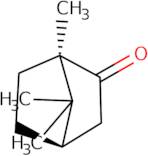
(+)-Camphor
CAS: 464-49-3
Ref. 3D-FC62560
| 25g | Nachfragen | ||
| 50g | Nachfragen | ||
| 100g | Nachfragen | ||
| 250g | Nachfragen | ||
| 500g | Nachfragen |
Produktinformation
- (+)-2-Bornanone
- (+)-Bornan-2-Ona
- (+)-Bornan-2-on
- (+)-Bornan-2-one
- (+)-Bornane-2-One
- (1R)-(+)-amphor
- (1R)-1,7,7-trimethylbicyclo[2.2.1]heptan-2-one
- (1R)-Camphor
- (1R,4R)-(+)-Camphor
- (1R,4R)-1,7,7-Trimethylbicyclo(2.2.1)heptan-2-one
- Mehr Synonyme anzeigen
- (R)-Camphor
- <span class="text-smallcaps">D</span>-(+)-Camphor
- Ai3-01698
- Alcanfor
- Bicyclo(2.2.1)heptan-2-one, 1,7,7-trimethyl-, (1R)-
- Bicyclo(2.2.1)heptan-2-one, 1,7,7-trimethyl-, (1R,4R)-
- Bicyclo(2.2.1)heptan-2-one, 1,7,7-trimethyl-, (1theta)-
- Camphor USP
- Camphor, (+)-
- Camphor, (1R,4R)-(+)-
- Camphor, Camphor
- Camphor, D-
- Dextrocamphora
- FEMA No. 2230
- Formosa camphor
- Japanese camphor
- Laurel camphor
- Unii-N20Hl7Q941
- d-2-Bornanone
- d-2-Camphanone
- d-Camphor
- D-(+)-Camphor
(+)-Camphor is a natural compound that can be found in plants such as the camphor tree. It has been shown to have a number of biological properties, including inhibiting the growth of resistant mutants and affecting mitochondrial membrane potential. (+)-Camphor also acts as a substrate molecule for the enzyme, catechol oxidase, which catalyzes the conversion of catechol to quinones. This reaction is used in wastewater treatment to reduce redox potentials by oxidizing organic matter. Camphor is also used in some household products such as mothballs, air fresheners and insect repellents. The optimum concentration for (+)-camphor is 10-20 ppm.
Chemische Eigenschaften
Technische Anfrage zu: 3D-FC62560 (+)-Camphor
Wenn Sie ein Angebot anfordern oder eine Bestellung aufgeben möchten, legen Sie stattdessen die gewünschten Produkte in Ihren Warenkorb und fordern Sie dann ein Angebot oder eine Bestellung an aus dem Warenkorb. Es ist schneller, billiger und Sie können von den verfügbaren Rabatten und anderen Vorteilen profitieren.





